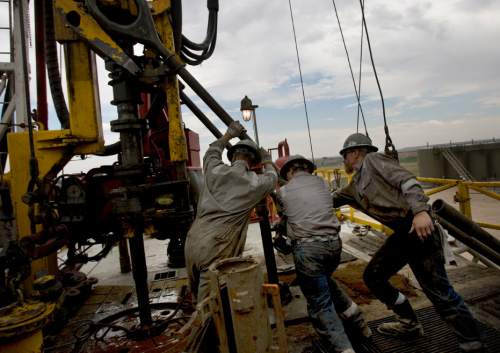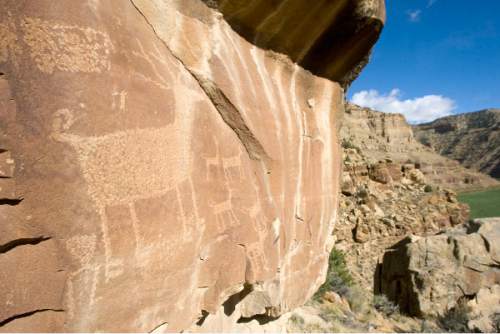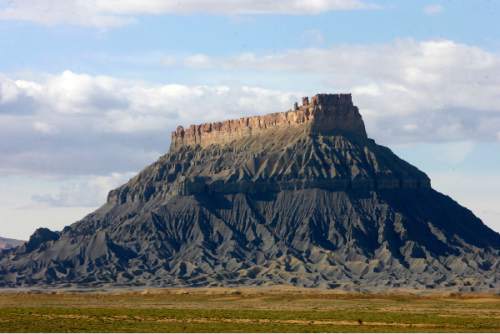This is an archived article that was published on sltrib.com in 2015, and information in the article may be outdated. It is provided only for personal research purposes and may not be reprinted.
The accounting of a federal land transfer depends on a lot of assumptions.
Utah can afford to take over 31.2 million acres managed by the federal government, according to a long-awaited economic study, but only if oil and gas prices remain stable and energy production stays on pace with the recent boom years.
The balance sheet also relies on energy revenues that currently pay for road construction being diverted to fighting wildfires and other land-management obligations.
A cadre of researchers from three public universities released a 784-page report Monday that is intended to guide state leaders in their long-term quest to gain control of federal land administered by the Bureau of Land Management and U.S. Forest Service.
Gov. Gary Herbert's public lands advisers praised the report as "an optimistic, yet cautionary, examination" of the controversial move.
Environmentalists condemn the plan as an effort to throw open Utah's public lands to industrial development without regard for federal environmental-protection laws. They figure the transfer would result in a sell-off of public lands.
The economists' report says transferring federal lands would cost Utah $245 million a year, about a third of that associated with fire suppression and fuels management. That's in addition to the loss of $35 million in federal Payments in Lieu of Taxes to counties, which the state has pledged to offset.
The state could make up the costs with oil and gas revenues alone, according to the economists' model. But certain assumptions must hold true.
On average between 2008 and 2012, the federal government generated about $330 million a year in revenue from the acreage in play. More than three-fourths of that money comes from oil and gas development.
"The study shows there is clearly enough," said John Harja, one of Herbert's senior public lands advisers.
Or the state could spend less managing public lands, he added. "The Legislature can look at a variety of options."
But if the oil and gas boom doesn't hold out, prices fall or the federal government declines to hand over 100 percent of the royalties from thousands of existing wells, Utah could face a serious shortfall. Federal managers currently split a 12.5 percent mineral royalty with the state — money local governments depend on for roads and other civic infrastructure.
"This money is spoken for," said co-author John Downen, a researcher with University of Utah's Bureau of Economic and Business. "Those are no longer federal lease revenues. The state would have to rewrite the rules about how this money is distributed."
Herbert's public lands advisers claimed the study shows the state won't have to sell a single acre.
"It demonstrates that a transfer of the public lands can be an economically sound pathway to a more balanced public lands policy," the Public Lands Policy Coordination Office wrote in a summary. "The study demonstrates that this can be accomplished without sacrificing the beauty of our state, the quality of our life, or the attraction of Utah to tourists and recreationists from around the country and the world."
But critics of the land transfer reached the opposite conclusion.
The lands policy office, which commissioned the study under legislative direction, presents its own 28-page summary Wednesday to the Commission for the Stewardship of Public Lands.
Meanwhile, critics used the study's release to renew their opposition to a regional movement among Western conservatives to "take back" vast swaths of public lands within their states' borders. The new economic report confirms that the costs of state oversight far outweigh the benefits, they contend.
"Their analysis describes in plain terms just how costly and fiscally reckless this land grab scheme really is," said Matt Lee-Ashley, senior fellow at the Center for American Progress. "The bottom line is that seizing America's public lands will result in some mix of higher taxes for Utah taxpayers, a growth in state government, fewer visitors to the state, and a pile of new debt for the country."
Other critics of land transfer say the revenue currently dedicated to infrastructure investments should not be counted toward covering the massive costs associated with managing landscapes — from the High Uintas, San Rafael Swell, Flaming Gorge, the Grand Staircase, Cedar Mesa, West Desert and various mountain ranges, including the Wasatch, Tushars, La Sals and Deep Creeks.
The Southern Utah Wilderness Alliance contends the study provides further proof that the state can manage those lands only thorough increased drilling and mining, at the expense of natural values that sustain Utah's tourism economy and quality of life.
"They have figures out there that under many scenarios the state will lose significant amounts of money. If you have a car you can't afford payments on, what do you do? You sell it," said SUWA staff attorney David Garbett. "When will the Legislature realize that the public does not want to see the Wasatch Mountains barricaded with 'No Trespassing' signs, the Book Cliffs lost to tar sand strip mines, or Arches National Park ringed with oil and gas development?"
Harja argues it is not fair for critics to single out a scenario to prove their point.
"This is extremely complex," he said. "If the price of oil goes down, you have to deal with less revenue and the Legislature has proven it can address that."
The study also found modest amounts of federal land are associated with strong economic growth in some counties, but too much public land slows growth.
"The turning point at which the drag begins is county-specific, but overall occurs when 40 to 45 percent of a county's land is owned and managed for multiple uses by federal agencies," the U. economic research center states. "Twenty of Utah's 29 counties exceed this threshold.
"The findings also show that the amount of state-owned land managed for multiple uses does not aid economic growth until state-owned land has reached a critical mass of about 15 percent of the county area. After that point, state management is associated with faster economic growth."
By the numbers:
Economists from the University of Utah's Bureau of Economic and Business Research, Utah State University and Weber State University released a 784-page report on the cost of transferring 31.2 million acres of federal land to the state.
Cost of the transfer: $280 million
— Average annual Bureau of Land Management spending on Utah public lands: $118.6 million (2003-2012)
— U.S. Forest Service costs (2012): $102 million ($51.1 million in wages)
— Average annual cost of wildfire suppression: $33.4 million (2003-2012)
Revenues raised (from oil and gas leases, grazing leases and recreation fees in 2013): $331.7 million
— Oil and gas royalties: $257 million
Federal lands' impact on Utah
Jobs supported by federal lands recreation and development: 29,000
Earnings of federal employees and other workers: $1.6 billion
Gross state product: $3.6 billion
Tax revenue to state and local governments: $788 million. › XX









